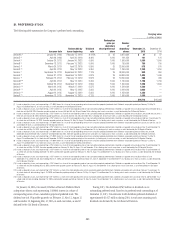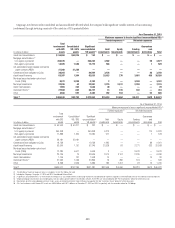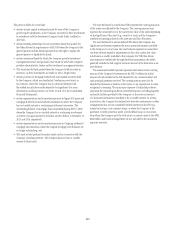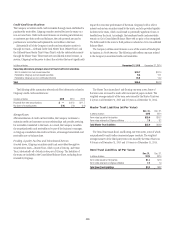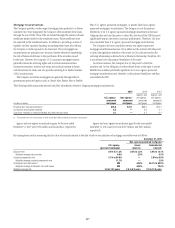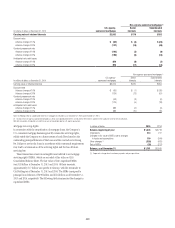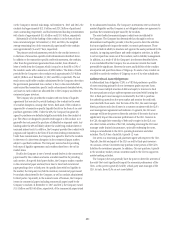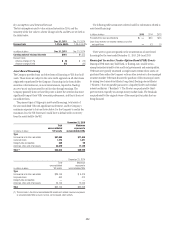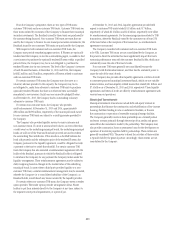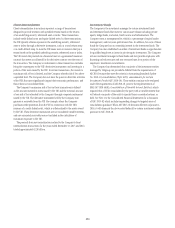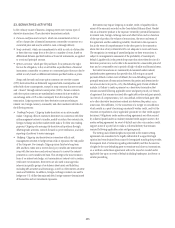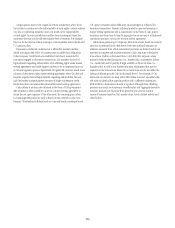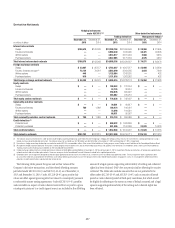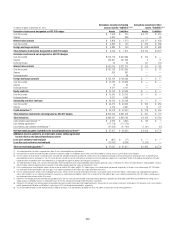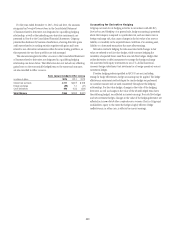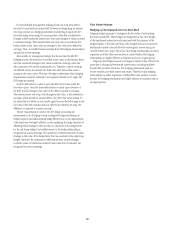Citibank 2015 Annual Report Download - page 249
Download and view the complete annual report
Please find page 249 of the 2015 Citibank annual report below. You can navigate through the pages in the report by either clicking on the pages listed below, or by using the keyword search tool below to find specific information within the annual report.231
on the Company’s internal risk ratings. At December 31, 2015 and 2014, the
conduits had approximately $21.3 billion and $29.2 billion of purchased
assets outstanding, respectively, and had incremental funding commitments
with clients of approximately $11.6 billion and $13.5 billion, respectively.
Substantially all of the funding of the conduits is in the form of short-
term commercial paper. At December 31, 2015 and 2014, the weighted
average remaining lives of the commercial paper issued by the conduits
were approximately 56 and 57 days, respectively.
The primary credit enhancement provided to the conduit investors is
in the form of transaction-specific credit enhancements described above.
In addition to the transaction-specific credit enhancements, the conduits,
other than the government guaranteed loan conduit, have obtained a
letter of credit from the Company, which is equal to at least 8% to 10% of
the conduit’s assets with a minimum of $200 million. The letters of credit
provided by the Company to the conduits total approximately $1.9 billion
and $2.3 billion as of December 31, 2015 and 2014, respectively. The net
result across multi-seller conduits administered by the Company, other than
the government guaranteed loan conduit, is that, in the event defaulted
assets exceed the transaction-specific credit enhancements described above,
any losses in each conduit are allocated first to the Company and then the
commercial paper investors.
The Company also provides the conduits with two forms of liquidity
agreements that are used to provide funding to the conduits in the event
of a market disruption, among other events. Each asset of the conduits is
supported by a transaction-specific liquidity facility in the form of an asset
purchase agreement (APA). Under the APA, the Company has generally
agreed to purchase non-defaulted eligible receivables from the conduit at
par. The APA is not designed to provide credit support to the conduit, as it
generally does not permit the purchase of defaulted or impaired assets. Any
funding under the APA will likely subject the underlying conduit clients to
increased interest costs. In addition, the Company provides the conduits with
program-wide liquidity in the form of short-term lending commitments.
Under these commitments, the Company has agreed to lend to the conduits
in the event of a short-term disruption in the commercial paper market,
subject to specified conditions. The Company receives fees for providing
both types of liquidity agreements and considers these fees to be on fair
market terms.
Finally, the Company is one of several named dealers in the commercial
paper issued by the conduits and earns a market-based fee for providing
such services. Along with third-party dealers, the Company makes a market
in the commercial paper and may from time to time fund commercial
paper pending sale to a third party. On specific dates with less liquidity in
the market, the Company may hold in inventory commercial paper issued
by conduits administered by the Company, as well as conduits administered
by third parties. Separately, in the normal course of business, the Company
invests in commercial paper, including commercial paper issued by the
Company's conduits. At December 31, 2015 and 2014, the Company owned
$11.4 billion and $10.6 billion, respectively, of the commercial paper issued
by its administered conduits. The Company's investments were not driven by
market illiquidity and the Company is not obligated under any agreement to
purchase the commercial paper issued by the conduits.
The asset-backed commercial paper conduits are consolidated by
the Company. The Company has determined that, through its roles as
administrator and liquidity provider, it has the power to direct the activities
that most significantly impact the entities’ economic performance. These
powers include its ability to structure and approve the assets purchased by the
conduits, its ongoing surveillance and credit mitigation activities, its ability
to sell or repurchase assets out of the conduits, and its liability management.
In addition, as a result of all the Company’s involvement described above,
it was concluded that the Company has an economic interest that could
potentially be significant. However, the assets and liabilities of the conduits
are separate and apart from those of Citigroup. No assets of any conduit are
available to satisfy the creditors of Citigroup or any of its other subsidiaries.
Collateralized Loan Obligations
A collateralized loan obligation (CLO) is a VIE that purchases a portfolio
of assets consisting primarily of non-investment grade corporate loans.
The CLO issues multiple tranches of debt and equity to investors to fund
the asset purchases and pay upfront expenses associated with forming the
CLO. A third-party asset manager is contracted by the CLO to purchase
the underlying assets from the open market and monitor the credit risk
associated with those assets. Over the term of the CLO, the asset manager
directs purchases and sales of assets in a manner consistent with the CLO’s
asset management agreement and indenture. In general, the CLO asset
manager will have the power to direct the activities of the entity that most
significantly impact the economic performance of the CLO. Investors in
the CLO, through their ownership of debt and/or equity in the CLO, can
also direct certain activities of the CLO, including removing the CLO asset
manager under limited circumstances, optionally redeeming the notes,
voting on amendments to the CLO’s operating documents and other
activities. The CLO has a finite life, typically 12 years.
Citi serves as a structuring and placement agent with respect to the CLO.
Typically, the debt and equity of the CLO are sold to third-party investors.
On occasion, certain Citi entities may purchase some portion of the CLO’s
liabilities for investment purposes. In addition, Citi may purchase, typically
in the secondary market, certain securities issued by the CLO to support its
market making activities.
The Company does not generally have the power to direct the activities of
the entity that most significantly impact the economic performance of the
CLOs, as this power is generally held by a third-party asset manager of the
CLO. As such, those CLOs are not consolidated.


